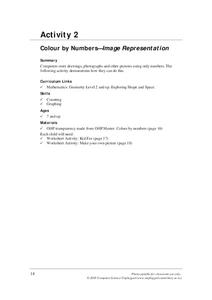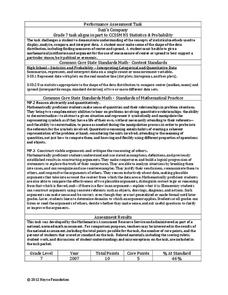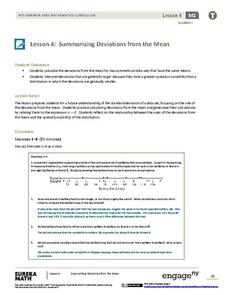Curated OER
Halloween Dot to Dot - Numbers 1-23
In this Halloween dot to dot worksheet, 1st graders start at the number 1 and work through to the number 23. They uncover a Halloween picture as they complete the puzzle.
Curated OER
Mouse Dot to Dot Worksheet, 1-41
In this dot to dot worksheet, 1st graders work from the number 1 to the number 41 to uncover a cartoon-like picture of a mouse holding a toy rabbit.
Curated OER
Number Cards
In this number cards worksheet, students use the number cards to help them count from 1 through 10. Students identify the numbers, number words, and number dots.
Curated OER
Join the Self Esteem Team!
In this character worksheet, 3rd graders complete two dot to dot puzzles. They help someone feel good about themselves and write about it in the star bursts on the page.
Curated OER
Activities for Fancy Nancy and the Posh Puppy
Students celebrate Fancy Nancy and the Posh Puppy. In this Fancy Nancy lesson, students are invited to a party complete with invitations and decorations, then complete worksheets by finding missing objects, showing how to take care of a...
Curated OER
Number Patterns: Triangular & Square Numbers
Learners explore the patterns found in triangular and square numbers. In this number pattern activity, students complete a worksheet exploring the relationship between triangular numbers and square numbers.
Curated OER
Addition and Connecting Dots in a Picture
For this addition worksheet, students solve 60 problems in which one and two digit numbers are added. Students use the sums to connect the dots in a complex picture of the Eiffel Tower.
Curated OER
DeNelian Printing Practice- A to Z with Words
In this language arts worksheet, students learn to form both upper and lower case DeNelian letters A-Z. Students trace the dotted examples of each letter and words that begin with that letter. Students then form their own examples on the...
Concord Consortium
Circling
Come full circle in learning about conic sections. Learners first look at the type of conic section formed when concentric circles intersect a standard coordinate plane. They then see which type forms when two sets of concentric circles...
NASA
Raisin Bread Universe
What is the universal breakfast? The resource includes two activities, the first one observing oatmeal to understand the texture of the universe. Then, scholars measure raisin bread dough before and after it rises to represent the...
Computer Science Unplugged
Marching Orders—Programming Languages
Computers need precise directions to complete a task. Class members experience what it is like to program a computer with an activity that asks one pupil to describe an image while classmates follow the directions to duplicate the picture.
Teach Engineering
Fun With Nanotechnology
Introduce your class to nanotechnology applications with three demonstrations that showcase scientific principles related to ferrofluids, quantum dots, and gold nanoparticles. Groups will work more closely with these applications in the...
EngageNY
Measuring Variability for Symmetrical Distributions
How do we measure the deviation of data points from the mean? An enriching activity walks your class through the steps to calculate the standard deviation. Guiding questions connect the steps to the context, so the process...
Dick Blick Art Materials
Woodsies “Extraordinaire”
"This looks like an owl!" Kids get a chance to create all sorts of things by arranging various shapes, painting them, and gluing them together. A great way to encourage creativity and spontaneity.
Curated OER
James and the Giant Peach Plot Analysis
It's all about the plot, main events, and story mapping with this lesson. As the class reads the novel James and the Giant Peach, they create an excitement graph that actually charts key events and moments of excitement. After...
Computer Science Unplugged
Colour by Numbers–Image Representation
How do computers store and send images? Here's an activity that explains one way a computer can compress image information. Pupils decode run-length coding to produce a black and white image. Pairs then work together to code and...
Inside Mathematics
Suzi's Company
The mean might not always be the best representation of the average. The assessment task has individuals determine the measures of center for the salaries of a company. They determine which of the three would be the best representation...
Hookshot Creative
Compose Your Own Music
Channel the masters with an interactive music composition activity! Learners use the online tool to create their own masterpieces one measure at a time.
Curated OER
Aboriginal Hand Prints
A part of a study of Australian Aboriginal culture, class members listen to a Dreamtime story about a father who stenciled his handprint on a rock wall. Class members then make their own hand print art representative of themselves...
EngageNY
Summarizing Deviations from the Mean
Through a series of problems, learners determine the variability of a data set by looking at the deviations from the mean. Estimating means of larger data sets presented in histograms and providing a way to calculate an...
Statistics Education Web
Who Sends the Most Text Messages?
The way you use statistics can tell different stories about the same set of data. Here, learners use sets of data to determine which person sends the most text messages. They use random sampling to collect their data and calculate a...
Utah Education Network (UEN)
Statistics
Find the value in analyzing data values. Statistics is the focus in the fifth of seven installments of the 6th Grade Math series. Individuals learn to examine dot plots, histograms, and box plots by considering the shape, mean, median,...
Khan Academy
Challenge: Mouse Tracker
Create a small but useful little program that allows you move a dot with your mouse and see the coordinates change as the mouse moves. Starting with a dot that moves with the mouse, add to this program the text of the points...
EngageNY
Understanding Variability When Estimating a Population Proportion
Estimate the proportion in a population using sampling. The 20th installment in a series of 25 introduces how to determine proportions of categorical data within a population. Groups take random samples from a bag of cubes to determine...























